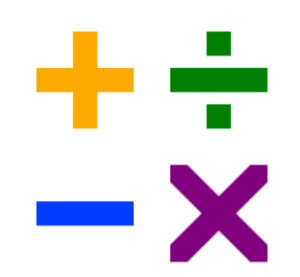8 RtI/MTSS – Math

Math Interventions
Math interventions within the Response to Intervention (RtI) and Multi-Tiered System of Supports (MTSS) framework are essential to supporting readers who are showing signs of difficulties with math. RtI and MTSS frameworks provide a structured way to ensure all students receive the math instruction, intervention, and support they need to succeed. It moves away from a “wait-to-fail” model towards early identification and targeted help.
Tier 1 instruction provides effective, evidence-based math instruction to all students in the general education classroom, meeting the needs of the majority (~80%). This can prevent math difficulties from developing, especially with the use of universal screening and early intervention in place. The National Council of Teachers of Mathematics (NCTM) states, “true collaboration for effective intervention in a preventative model (e.g., Response to Intervention, Multi-Tiered System of Supports) requires advanced planning between the special and mathematics educators (NCTM, 2024). Tier 1 instruction happens with a research-based core math curriculum implemented with fidelity. Instruction incorporating effective practices. Tier 1 instruction involves teaching strategies such as direct instruction, teacher modeling, guided practice, and independent practice. Some strategies used in Tier 1 instruction include visual aids, the use of mathematical think/pair/share opportunities, and purposeful activities that increase numeracy and fluency building. In Tier 1 instruction, teachers should appropriately use differentiated instruction to support learners who may need additional support. As noted earlier, all Tiers involve data collection and analysis to support student placement in interventions.
Once students are identified as needing Tier 2 targeted math intervention, they do not stop receiving Tier 1 intervention. This is approximately ~15% of students in a classroom. Tier 2 targeted intervention provides supplemental, focused instruction for students identified as not making adequate progress with Tier 1 instruction alone. This targeted intervention occurs in the general education classroom, in a small group setting, with students with similarly documented math needs. This should be additional math instruction beyond what they receive in Tier 1 instruction, for example, 3x per week for 30 minutes. Tier 2 interventions may focus on specific areas identified through diagnostic assessment like number sense, place value, computation facts, fraction concepts, word-problem strategies. Interventions should be research-based, more explicit and systematic than Tier 1 instruction.
When Tier 2 intervention is not working for students, they are identified as needing Tier 3 intensive interventions. This is intensive, individualized support, ~5% – 10% of students with significant math difficulties. There may be suspicions of a math-related learning disabilities like dyscalculia, math-calculation learning disabilities, math problem-solving learning disabilities. When they have not responded to Tier 1 and Tier 2 interventions, Tier 3 intervention is appropriate.
This intensive intervention should occur one on one or in very small groups of 1-3, not more than three students, to maintain the fidelity of student support at this level. This might occur four to five times per week for 30-45 minutes in addition to Tier 1 intervention. This math support is tailored to the students’ individual needs that may have been assessed using a diagnostic assessment and includes data from previous intervention tiers.
In Tier 3 intervention, there are several ways to support student learning needs. It is important to start by focusing on addressing foundational gaps and fundamental misconceptions with regards to number sense, place value, and/or basic operations. This intervention is typically delivered by content specialists or in close consultation with a content specialist or special education teacher. This stage may also be a part of the process for determining eligibility for the special education process. Data collected during tier 3 intervention includes intensive progress monitoring, comprehensive diagnostic assessments that help pinpoint areas of specific need, and cognitive evaluation of results where appropriate. It is essential for math interventions to be implemented effectively within an RtI/MTSS framework. It requires strong core instruction, accurate and reliable assessment, implementation of evidence-based intervention practices, and ongoing data analysis to ensure students receive appropriate support in a timely manner.
Gersten et al. (2009) made eight recommendations for math interventions in an RTI model that were as follows:
- Schools provide screening to all students to identify those at risk for potential mathematics difficulties
- Instructional materials for students in math interventions should place focus intensely on whole numbers in kindergarten through Grade 5 and on rational numbers in Grades 4 through 8
- Math RtI intervention should be systematic and explicit
- Math interventions should include explicit instruction on solving word problems
- All intervention resources and materials should include opportunities for students to work with visual representations of mathematical ideas and teachers should be proficient in the use of visual representations
- Around 10 minutes of all math interventions at all grade levels should be dedicated to building fluency of basic arithmetic facts
- Progress monitoring of students receiving RtI math supplemental Tier 2 and Tier 3 intervention
- Math interventions should include motivational strategies.
Check out the Institute for Education Sciences recommendations for explicit, systematic math intervention instruction here
Math Interventions
Peer-Assisted Learning Strategies – intervention that focuses on structured math lessons (can also be used for reading)
Cognitive Guided Instruction (CGI) – intervention that focuses on word problems
i-Ready Math Intervention – adaptive core math intervention computer-based program
Math Fact Fluency – this intervention focuses on building math fluency
NCTM Illuminations – this is a comprehensive resource for math lesson for all grade levels
Additional Resources
Mathematics_Intervention_Resources
References
National Council of Teachers of Mathematics. (n.d.). Teaching mathematics to students with disabilities. NCTM. https://www.nctm.org/Standards-and-Positions/Position-Statements/Teaching-Mathematics-to-Students-with-Disabilities/

